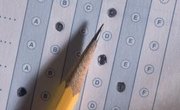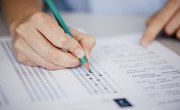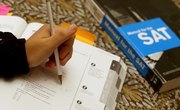The General Education Development test, which is designed to measure whether your education is equivalent to a high school education, contains five separate sections. You must score at least 410 out of 800 points in each section to pass the test, and your score over the five sections must average at least 450 points per section, meaning your total score must be at least 2,250. Studying the right subjects can help you pass the GED.
Language Arts - Writing
The writing section of the GED consists of two parts: 50 multiple-choice questions and one essay. The multiple choice questions will test your understanding of sentence structure and mechanics, how to use words and punctuation properly, and how to organize your writing. There is an essay portion that will assess your writing skills, vocabulary and ability to form coherent sentences.
Social Studies
The second section of the GED tests your understanding of social studies. You will have 70 minutes to answer 50 multiple choice questions that address a broad range of fields. The test will contain questions on American history, civics and government, economics, geography and world history. The sections on American history, economics and civics and government are the biggest part of the test, so focus on those areas when you are studying for the GED.
Science
You have slightly longer for the science section than you do for social studies--a total of 80 minutes to answer 50 multiple choice science questions. These questions will cover life science, physical science, and earth and space science. Life science accounts for 45 percent of the questions for the section and physical science accounts for 35 percent. For the highest score, spend more of your study time on these subjects than on earth and space science.
Language Arts - Reading
The GED reading section does not contain an essay, as the writing section did. Instead, it contains 40 multiple-choice questions which you must answer within 65 minutes. You will have to read and interpret various selections of fiction, poetry, drama and non-fiction, then answer questions about the excerpts you read. Seventy-five percent of the test will be on fiction and literature, with the other 25 percent dealing with nonfiction prose, so brush up on your poetic and literary interpretation skills.
Mathematics
The mathematics section of the GED is divided into two segments, each of which is 45 minutes long and contains 25 questions. These are not all multiple choice questions; about 20 percent require you to fill in your answer in a grid instead. You can use a scientific calculator in the first segment of this test, but must complete the second segment mentally or on paper. The questions are fairly evenly divided between four sections: operations and number sense; analysis, statistics and probability; measurement and geometry; and algebra, functions and patterns.
Related Articles
References
Writer Bio
Morgan O'Connor has been writing professionally since 2005. Her experience includes articles on various aspects of the health-insurance industry for health-care newsletters distributed to hospitals as well as articles on both international and domestic travel.










